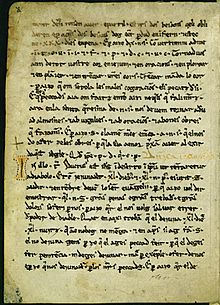Homilies d'Organyà facts for kids
Quick facts for kids Homilies d'Organyà |
|
|---|---|

Page of Homilies d'Organyà
|
|
| Author(s) | Unknown |
| Language | Catalan |
| Date | end of the 12th century |
| Provenance | Santa Maria d'Organyà, Organyà, Catalonia |
| State of existence | Kept in National Library of Catalonia |
| Genre | Religion |
| Length | 8 leaves of paper; 23 lines each page, 50-55 words each line |
| Subject | Six sermons on various gospels and epistles |
The Homilies d'Organyà are one of the oldest known books written in the Catalan language. They are very important because they show how the Catalan language was developing a long time ago. The language in these texts is somewhere between old vulgar Latin and the Catalan we know today.
Other very old Catalan texts include a part of the Forum iudicum, a promise from 1098, and the Greuges de Guitard Isarn from 1080–1091. Some Catalan notes found in Latin documents from as far back as 1034 are also very old.
The Homilies d'Organyà were found in a church office in Organyà in 1904. Dr. Joaquim Miret i Sans, a historian, discovered them. These writings are from the late 1100s. They contain six sermons, which are like speeches or lessons. These sermons explain different parts of the gospels and epistles (letters from the Bible).
The original book is kept safe in the National Library of Catalonia. You can also see a copy of it in Organyà.
Where Did the Homilies Come From?
The homilies found in Organyà are similar to others discovered in Tortosa in the late 1800s. Both sets of writings include the same sermon about Ash Wednesday. This connection suggests they came from similar collections of sermons used in the past. These collections were popular in a region called Provence.
The Tortosa homilies are direct copies of the Provençal texts. They have a simpler, more common style. However, the Homilies d'Organyà are translations into Catalan. They use a more formal and educated style of writing.
How Old Is the Language?
The language in the Homilies d'Organyà is very old. It shows an early stage of the Catalan language. For example, it uses words like plader (which means "to please" or "to oblige"). It also uses pad for "peace" and crod' for "cross." The word fed means "make" (as a command to many people).
You can also see older grammar. For instance, the word soms means "we are." In modern Catalan, this is som. Another example is vulams, which means "we love" or "we like." Today, this would be vulguem.
Sometimes, the way words are spelled or sound shows influences from Provençal. This is because the Catalan areas and the Occitan territories (where Provençal was spoken) had strong connections. They shared political, economic, and cultural ties.
See also
 In Spanish: Homilías de Orgañá para niños
In Spanish: Homilías de Orgañá para niños 
- Old Catalan

